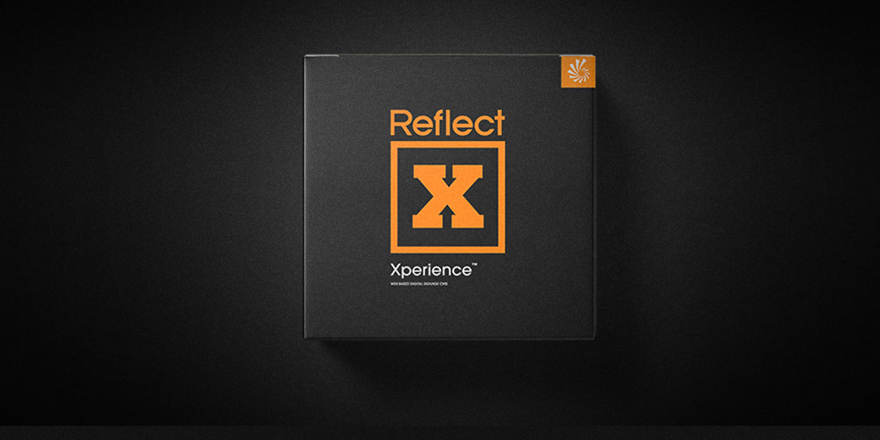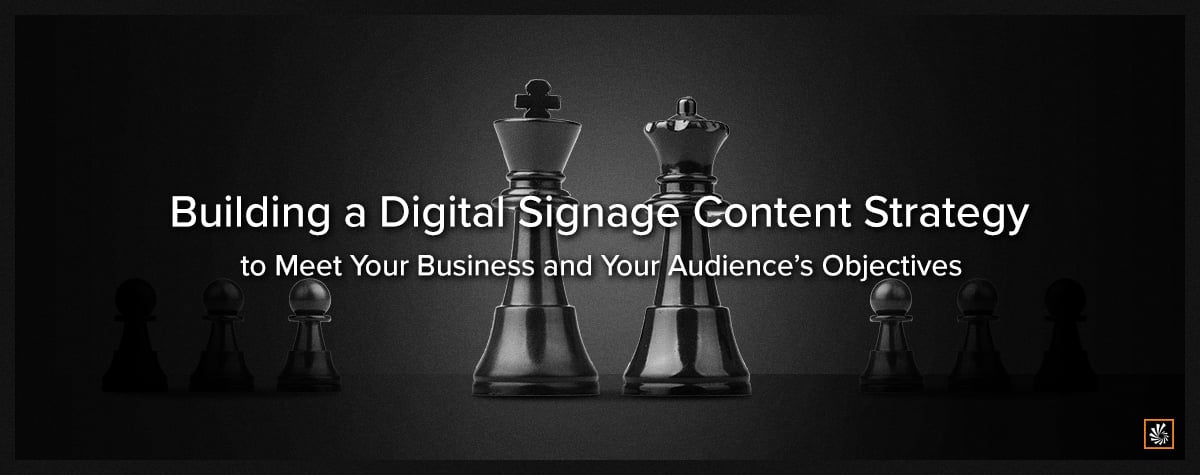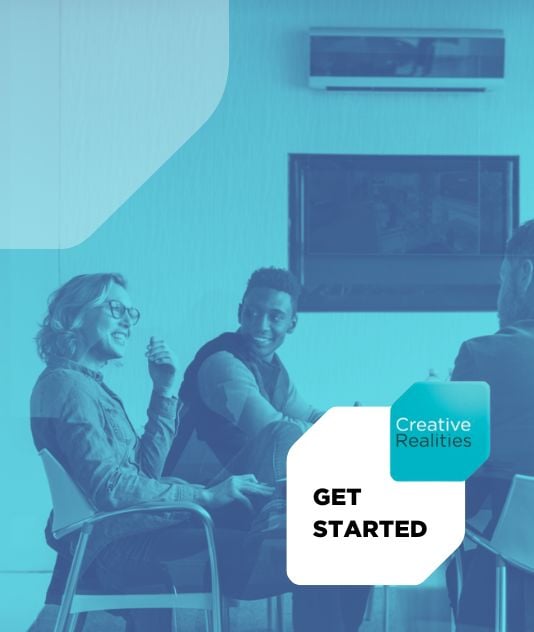Feeding the Beast: A Digital Signage Content Program for the Long Haul
You’ve defined your digital signage content strategy, and you’ve identified the types of content you will need for a wide range of venues, purposes, audiences, and devices. That’s great! Now the question is, how do you keep the momentum going? After all, digital signage content creation isn’t a once-and-done proposition.
Of course, you should always leverage the benefits and uniqueness of the medium—you can address each screen individually, update the content quickly, and target audiences by time of day, day of week, geographic location, and area of the venue. But the overall goal is to not let your digital signage content get stale.
While not every application of digital signage requires content changes on a daily basis, a lack of high-quality, up-to-date, and relevant content inevitably causes your audience to lose interest. Eventually, they’ll simply come to ignore your screens, meaning that even when you do load new content, it may simply go unseen. The same goes for content that is too busy or hard to interpret at a glance—even if it is current and relevant.
Making a plan to create and deploy quality digital signage content is one thing, but you must define and follow an ongoing program to nurture your content strategy. Not keeping your content up to snuff can end up causing the entire strategy to fail. How then do you “feed the beast,” so to speak? Here are a few tips.
Plan the resources and the budget for it
It is easy to look at digital signage as a project to complete and launch rather than an ongoing program to put in place and manage. Producing the content needed to support the program requires setting aside a budget and resources beyond the initial capital outlay for the physical devices and network. These may be existing human resources, including in-house staff or agency partners that can help with content creation. You may also have existing content production and workflow systems in place you can leverage, especially if you're looking to incorporate signage as another communications channel.
Just remember that digital signage is a unique medium. You may need different skills and software applications if you’re going to effectively leverage some of its content types. Creating dynamic media, for example, may be smarter and more effective than producing video clips for everything that you need in the content program. It does, however, require different resources, tools, and skills.
Determine the right cadence for new content experiences
Another thing to keep in mind about successfully feeding the content beast is that not every digital signage network will require the same cadence for producing fresh content. You should define the “refresh rate” for your content program as part of the content strategy phase. That’s because this cadence comes from your goals for the signage in the first place.
To reiterate, each screen should have its own goals and purpose, so each may have its own cadence, too. Before you think this is simply too overwhelming to manage, a quick clarification on this point about every screen being unique. For many companies, there are a finite number of layouts for each of their locations. For example, a retailer may have four basic store layouts. Within each layout, there might be four screens, each placed based on that store’s specific layout. Even if this retailer has 2,000 locations, they don’t need to plan a program for 8,000 screens. In this case, the content program would likely cover the 16 possible combinations of store and screen layout.
Meanwhile, screens used for promotional purposes may require that you refresh content based on a calendar and campaign cadence. Digital screens used for entertainment and informational purposes during long lines or wait times can not only leverage longer form content, but the content may not need to change as often. These and many other factors go into planning the appropriate length of content loops and the frequency of content updates. And while you may adjust and optimize the cadences over time, just like your business goals and selection of content types, they should all be part of the content program defined in your digital signage strategy—instead of figuring it out after you've deployed.
Delegate and democratize content creation for that “local” touch
One thing most organizations don’t do but should is use localized content to augment their centralized content supply chain, especially for those with multiple locations spread across a large geographic region. For example, we’ve already mentioned dynamic content that uses data sources (such as weather data) to make your content more locally relevant and personal to users in a venue.
But there’s another aspect of “localization” that can lessen the burden on your central corporate content creation teams, if properly done. For large organizations, why not let local employees contribute content unique to their own facilities. Obviously, individual stores could use digital signage for unique venue- and location-specific messaging and promotions. But why not allow local employees to contribute local news, happenings, and community events? These stories can then be displayed on screens in the regions, stores or even individual departments where it is most relevant. This eliminates extra steps and burden on the corporate content team while giving local employees a voice that contributes to employee engagement and the organization’s overall success.
Of course, delegation of local content will require some policies and oversight, as well as content creation tools that enable the functionality. For example, Reflect Xperience provides content templates, user roles and other features that allows local users to create and schedule custom messages and content while maintaining centralized control to ensure consistency.
Best practices for making content perform well on digital signage
Throughout your content program, it’s important to tailor your digital signage content to fully leverage this unique medium. Here are just a few factors and best practices to help achieve the best results:
- Objectives and purpose: Always remember your objectives and purpose for each screen—to entertain, inform, educate, assist with sales, etc. Does each piece of content you create for a device drive towards those goals?
- Screen size: Consider screen size when determining the destination for your content. Detailed video-based content isn’t as suitable to a small screen on a jewelry counter as to the big screen.
- Viewing Distance: Like screen size, the distance between the viewer and the screen affects the type and detail of the content—and touchscreens are worthless if the user can’t reach them.
- Dwell Time: Is the content suited for the traffic at the screen’s location? That is, should it be “glance” media or content for longer-term audiences?
- Audio: Some locations and venue are suited for audio content, others are not.
- Text: While this is true for most any type of signage, choose font sizes and color for their readability—and this will vary based on many of the above factors!
Measure your success, optimize, and keep it fresh
Creating the right content strategy and building content that creates engaging customer experiences are key to the success of your digital signage network. However, without purposeful and frequent measuring of the actual results, how will you really know how well the strategy is working—or whether you can improve it?
Just as with the content program itself and the content strategy before it, standing up a measurement program starts with defining the objectives for each digital media experience. You can then determine, for each objective, what metrics you can collect—for example, sales performance, customer satisfaction, or employee engagement—and use to determine success (or failure).
Before you can check for improvement, of course, you have to gather baseline numbers for the metrics of interest—which again emphasizes the need to define these measures up front, prior to deployment. Baselining provides a “current state,” prior to digital signage, so we can then turn our focus to further improving the results. (Just ask, and we’ll schedule a free workshop to develop a content strategy that includes success criteria and metrics, using our three-step process.)
We’re almost to the end of this series on the importance of quality digital signage content creation. Next time, we’ll review the steps taken to build a successful content strategy and wrap things up. In the meantime, we invite you to connect with us on LinkedIn and Twitter. Better yet, contact us to find out how Reflect Systems and its products and solutions—including our ReflectView digital signage content management platform—can help ensure you get the best possible ROI from your digital signage network and your content.
Share this
You May Also Like
These Related Stories

Choosing Digital Signage Content Types to Suit Your Needs

Reflect Xperience: How to Make Local Content for Digital Signage Work for You


